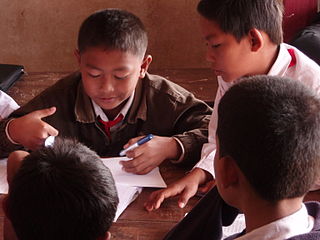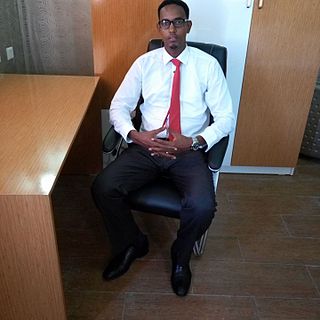Related Research Articles

The Universities of Wisconsin is a university system of public universities in the U.S. state of Wisconsin. It is one of the largest public higher-education systems in the country, enrolling more than 160,000 students each year and employing approximately 41,000 faculty and staff statewide. The system is headquartered in the state capital of Madison.
Education in China is primarily managed by the state-run public education system, which falls under the Ministry of Education. All citizens must attend school for a minimum of nine years, known as nine-year compulsory education, which is funded by the government.
The Carnegie Classification of Institutions of Higher Education, or simply the Carnegie Classification, is a framework for classifying colleges and universities in the United States. It was created in 1970 by the Carnegie Foundation for the Advancement of Teaching. It is managed by the American Council on Education.
Somali National University (SNU) is a national university in Mogadishu, the capital of Somalia. Its campus grounds were located four kilometers from the Mogadishu International Airport. It was established in 1971, but was "officially" founded in 1954. It closed in 1990. After closing down for a number of years, the university reopened in August 2014.
Education in Vietnam is a state-run system of public and private education run by the Ministry of Education and Training. It is divided into five levels: preschool, primary school, secondary school, high school, and higher education. Formal education consists of twelve years of basic education. Basic education consists of five years of primary education, four years of secondary education, and three years of high school education. The majority of basic education students are enrolled on a daily basis. The main goals are general knowledge improvement, human resources training and talent development.

Education in Rwanda has undergone considerable changes throughout Rwanda's recent history, and has faced major disruptions due to periods of conflict. Education was divided by gender whereby women and men had a different education relevant to their responsibilities in day-to-day life. Women were mostly taught housekeeping while men were mainly taught how to hunt, raise animals, and fish. This is because Rwanda was a community-based society where every member had a specific contribution to the overall development of the community. Older family members like grandparents usually took on the role of educators.
Education in the State of Palestine refers to the educational system in the Gaza Strip and the West Bank, which is administered by the Palestinian Ministry of Education and Higher Education. Enrollment rates amongst Palestinians are relatively high by regional and global standards. According to a youth survey in 2003, 60% between the ages 10–24 indicated that education was their first priority. Youth literacy rate is 98.2%, while the national literacy rate is 91.1%. Enrollment ratios for higher education were 45% in 2022. In 2016 Hanan Al Hroub was awarded the Varkey Foundation Global Teacher Prize for her work in teaching children how to cope with violence.

Education in Ethiopia was dominated by the Ethiopian Orthodox Church for many centuries until secular education was adopted in the early 1900s. Prior to 1974, Ethiopia had an estimated literacy rate below 50% and compared poorly with the rest of even Africa in the provision of schools and universities. After the Ethiopian Revolution, emphasis was placed on increasing literacy in rural areas. Practical subjects were stressed, as was the teaching of socialism. By 2015, the literacy rate had increased to 49.1%, still poor compared to most of the rest of Africa.
Afgooye is a town in the southeastern Somalia Lower Shebelle region of Somalia. It is the center of the Afgooye District. Afgooye is the third largest city of Southwest State. Afgooye is one of the oldest towns on the lower Shebelle valley, 30 kilometers north of Mogadishu. Afgooye is the site of Lafoole college, the first college of education in Somalia, built on the site of the battle of Lafoole of 1896. Afgooye is also known for the Istunka, the annual "stick fight" carnival commemorating the New Year in the riverine region. It was a trade center for the Silcis Dynasty in the medieval period then fell under Ajuran rule. Around the late 17th century, Afgooye became the capital of Geledi Sultanate.

Education in Somalia refers to the academic system within Somalia. The Ministry of Education is officially responsible for education in Somalia, with about 15% of the nation's budget allocated to scholastic instruction. The breakaway republic of Somaliland maintains its own advanced Ministry of Education.

Education in Chad is challenging due to the nation's dispersed population and a certain degree of reluctance on the part of parents to send their children to school. Although attendance is compulsory, only 68% of boys continue their education past primary school, and over half of the population is illiterate. Higher education is provided at the University of N'Djamena.

In 2005, the literacy rate in Laos was estimated to be 73%.

Education in Ivory Coast continues to face many challenges. Among sub-Saharan African countries, Ivory Coast has one of the highest literacy rates. According to The World Factbook - Central Intelligence Agency as of facts. The literacy rate for adults remains low: in 2000, it was estimated that only 48.7% of the total population was literate. Many children between 6 and 10 years are not enrolled in school, mainly children of poor families. The majority of students in secondary education are male. At the end of secondary education, students can sit the Baccalauréat examination. The country has universities in Abidjan, Bouaké, and Yamoussoukro.
Education in Seychelles is free and compulsory from the ages of 6 to 15. The language of instruction is Creole from ages 6 to 10, and then English is gradually introduced as the language of instruction, with French introduced as a foreign language. It has evolved from private mission schools to compulsory public education in the modern system. It is the only African country whose education system features among the top 50 in the world. Seychelles has the highest literacy rate of any country in sub-Saharan Africa at 96.20%. According to The World Factbook - Central Intelligence Agency as of 2018, 95.9% of the population age 15 and over can read and write in Seychelles were respectively literate.
Education in Uruguay is compulsory for a total of fourteen years, beginning at the preschool level, and is free from the pre-primary through the university level. In 1996, the gross primary enrollment rate was 111.7 percent, and the net primary enrollment rate was 92.9 percent. Primary school attendance rates were unavailable for Uruguay as of 2001.

Fuyang Normal University, previously known as Fuyang Teachers College, is an institution of higher learning in Fuyang city, Anhui province, China. It is the largest institution of higher learning in the city of Fuyang.

Bardera Polytechnic is a non-profit tertiary polytechnic education centre located in Bardera, Somalia. The college's full name is Bardera Polytechnic College (BPC). Bardera Polytechnic is the first post-secondary institution in Bardera and the larger Gedo region. Bardera Polytechnic is the first post civil war vocational training school in southern Somalia.

Asha Gelle Dirie is a Somali politician and civil society activist. From 2005 to 2012, she served as the Minister of Women Development and Family Affairs of the autonomous Puntland regional state in northeastern Somalia. Dirie is also the founder and Executive Director of The Asha Gelle Foundation. Additionally, she served as the Chairperson of the federal Constitutional Review and Implementation Commission between 2014 and 2015.
The June 2016 Mogadishu attacks were two similar attacks on hotels that occurred in Mogadishu, Somalia on 1 June and 25 June 2016. Dozens of people were killed in the attacks and many more were wounded.

Abbas Abdullahi Sheikh Siraji was a Somali politician who briefly served as the Minister of Public Works and Reconstruction until he was shot dead in Mogadishu in 2017.
References
- ↑ "Enrollment statistics" (PDF). Retrieved 15 August 2011.